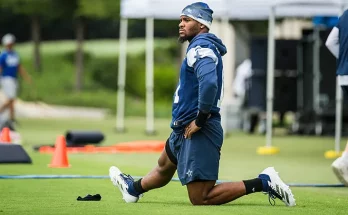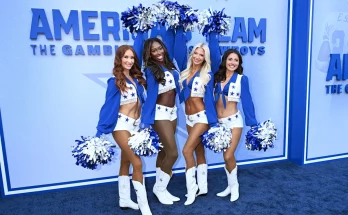Texas football has always been a program with larger-than-life expectations, and with the ever-changing dynamics of recruiting, player development, and transfer portal movements, stories surrounding young stars gain traction almost instantly. When news broke that Ohio State football would be starting Julian Sayin at quarterback, the ripple effects went far beyond Columbus. Among the many voices that chimed in was Colin Simmons, Texas football’s highly regarded defensive talent, who took to Instagram to react. His post did not go unnoticed, and it quickly stirred conversations among fans, recruits, and college football enthusiasts about not only Sayin’s debut but also what it means for Texas, Ohio State, and the broader recruiting battles between powerhouse programs.
To appreciate why Simmons’ response to Sayin’s rise at Ohio State matters, it is important to understand the context surrounding both athletes. Julian Sayin was one of the most hyped quarterbacks coming out of high school, carrying the kind of recruiting profile that draws national headlines. A polished passer with a strong arm, quick release, and advanced pocket presence, he was long viewed as a future star who could elevate whichever program landed him. The quarterback carousel at Ohio State in recent years made it almost inevitable that Sayin would eventually get his chance, but many were surprised at how quickly he has risen to the top of the depth chart. For Ohio State, it signals trust in a young player to lead one of the most talented rosters in the nation and an eagerness to continue their tradition of elite quarterback play.
Colin Simmons, on the other hand, is a defensive force for Texas and a player with a huge spotlight on him due to his high school pedigree and immediate impact potential. Coming from Duncanville, a Texas powerhouse, Simmons entered college football with a reputation as one of the best edge rushers in his class. His speed, technique, and relentless motor make him a name that offensive coordinators already must account for. Simmons is not only expected to contribute heavily to Texas’ defense but also to be a cornerstone for the program as it transitions fully into SEC play, where pass rushers of his caliber are vital in competing with the best. His reaction to Sayin’s starting role at Ohio State is more than just a casual Instagram post; it carries undertones of competitiveness, mutual recognition, and the intertwining storylines of top recruits choosing different paths in college football.
Social media has become a central stage for athletes to share thoughts, express confidence, and even stir rivalries without needing to say much at all. When Simmons posted about Sayin’s starting nod, fans were quick to interpret it as a mixture of respect, motivation, and subtle challenge. Was it admiration for another freshman making waves on a major stage? Was it a reminder that Simmons himself is ready to dominate in his role? Or was it both, a recognition that the new generation of college football stars is here and making their presence felt? Whatever the precise tone, the fact that Simmons took the time to acknowledge Sayin shows the interconnected world these athletes inhabit, where recruits from different states and programs are often aware of each other’s journeys and successes.
For Texas fans, Simmons’ post serves as an affirmation of the program’s competitiveness on the national stage. Texas and Ohio State are not just battling on the field but also in recruiting wars across the country. Sayin himself was once recruited by programs like Alabama and Texas before ultimately choosing Ohio State. Simmons, meanwhile, was courted by nearly every elite program before committing to the Longhorns. That both ended up at schools with rich histories and high expectations only fuels the comparisons. Texas fans see in Simmons not just a defensive star but also a cultural leader, someone who embodies confidence and isn’t afraid to highlight what’s happening around the college football landscape. His engagement with Sayin’s story positions Texas not in the shadows of national narratives but right in the middle of them.
Ohio State fans, meanwhile, likely view Simmons’ post as a testament to how impactful Sayin’s starting role already is. For a defensive player on another powerhouse program to immediately take notice and publicly comment, it underscores that Sayin is more than just another quarterback; he is someone whose play will be watched and dissected by peers across the country. For Ohio State, having Sayin step into the spotlight is a reminder of their long lineage of quarterbacks who not only excel at the collegiate level but often translate to NFL stardom. From Justin Fields to C.J. Stroud, the Buckeyes have established themselves as a quarterback factory, and Sayin’s opportunity is the continuation of that narrative.
Beyond the fan reactions, this exchange between Simmons and Sayin highlights the cultural moment college football is experiencing. These players grew up in the social media era, where highlights, mixtapes, and recruiting battles are all public, shared, and analyzed in real time. It creates a unique environment where top players know each other, follow each other, and often communicate through short bursts on platforms like Instagram or X. That Simmons is paying attention to Sayin’s start shows how interconnected this new wave of athletes really is. They are not just playing for their teams; they are building personal brands, following rivals, and setting the stage for narratives that stretch beyond the football field.
There is also an underlying layer of competitive fire in Simmons’ reaction. As a defensive end, quarterbacks are his primary targets, and Sayin now represents one of the premier young quarterbacks in the nation. Even though Texas and Ohio State may not face each other on the field in the immediate future, Simmons’ post can be interpreted as a subtle message that he is aware of who the top offensive players are and that he welcomes the challenge. College football thrives on these kinds of storylines—defensive stars keeping an eye on offensive prodigies, and vice versa—and Simmons’ willingness to acknowledge Sayin is a preview of the competitive narratives that will continue to unfold as both carve out their legacies.
For Texas, the story reflects the broader ambitions of the program. The Longhorns are moving into the SEC, where the level of competition is as high as it gets. Having players like Simmons who are not only aware of but actively engaged in national conversations is vital for the program’s identity. It signals confidence, swagger, and a refusal to be left out of the spotlight. Simmons’ acknowledgment of Sayin shows that Texas’ stars are not confined to Austin—they are watching the nation, taking note, and staking their place among the elites. This kind of mindset is what Texas needs as it attempts to reestablish itself as not just a strong program but a perennial contender for the College Football Playoff.
Looking forward, the Simmons-Sayin connection may well be part of a larger narrative that defines this era of college football. With the expanded playoff format on the horizon, Texas and Ohio State could find themselves meeting in postseason matchups more frequently than in the past. Imagine the storyline if Simmons and Sayin eventually square off in a high-stakes game, with one trying to lead his offense to victory and the other determined to stop him. That kind of matchup, teased by a simple Instagram post, could become the centerpiece of college football chatter years down the road.
In many ways, Simmons’ Instagram post is a microcosm of modern college football. It is about more than one player reacting to another; it is about the intersection of individual brands, program narratives, recruiting battles, and the growing importance of social media in shaping how fans perceive athletes. Simmons is not just a player for Texas—he is a representative of a new generation that blends athletic excellence with digital presence. His acknowledgment of Sayin reinforces how interconnected college football’s stars are and how much attention is given to each new development.
Ultimately, what stands out is how moments like this fuel the broader excitement for college football. Fans love the rivalries, the debates, and the speculation about what one player’s success means for another. Simmons recognizing Sayin’s rise at Ohio State may seem like a small gesture, but in the world of college football, small gestures can spark large narratives. It ties Texas and Ohio State together in subtle but meaningful ways and reminds fans that the sport is about more than just the games on Saturdays—it is about the culture, the personalities, and the ongoing stories that keep people engaged year-round.
Colin Simmons’ decision to take to Instagram after Julian Sayin was named the starter at Ohio State shows just how quickly news travels and how impactful these announcements can be across the college football landscape. For Texas fans, it is a glimpse into the competitive fire of their young star. For Ohio State fans, it is proof of Sayin’s instant relevance. And for college football as a whole, it is another reminder that we are witnessing a new era where athletes are not only playing the game but shaping the narrative around it in real time. The connection between Simmons and Sayin, sparked by a single Instagram post, may be just the beginning of a storyline that continues to grow as both carve out their paths in the sport.



